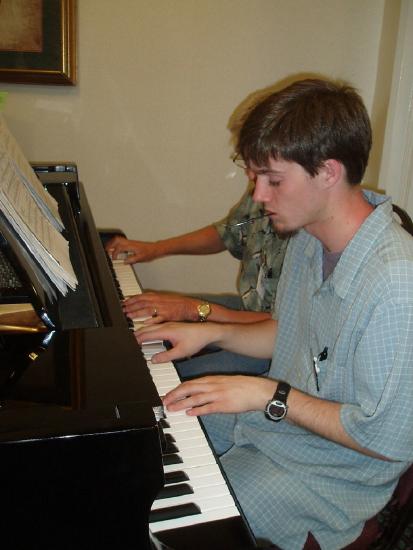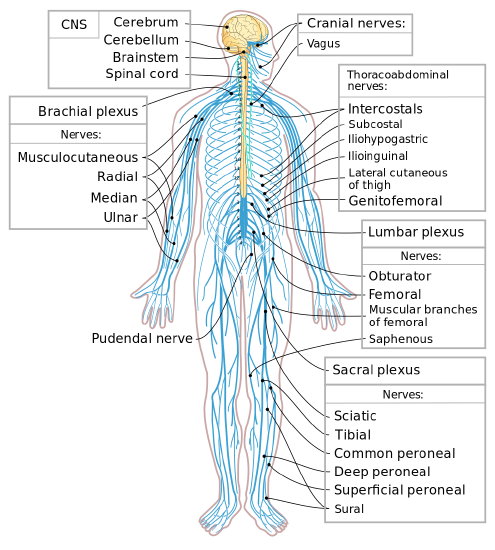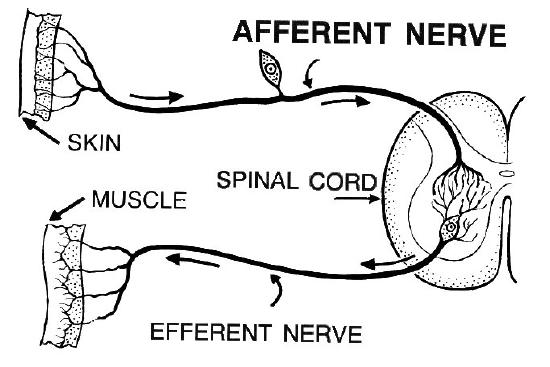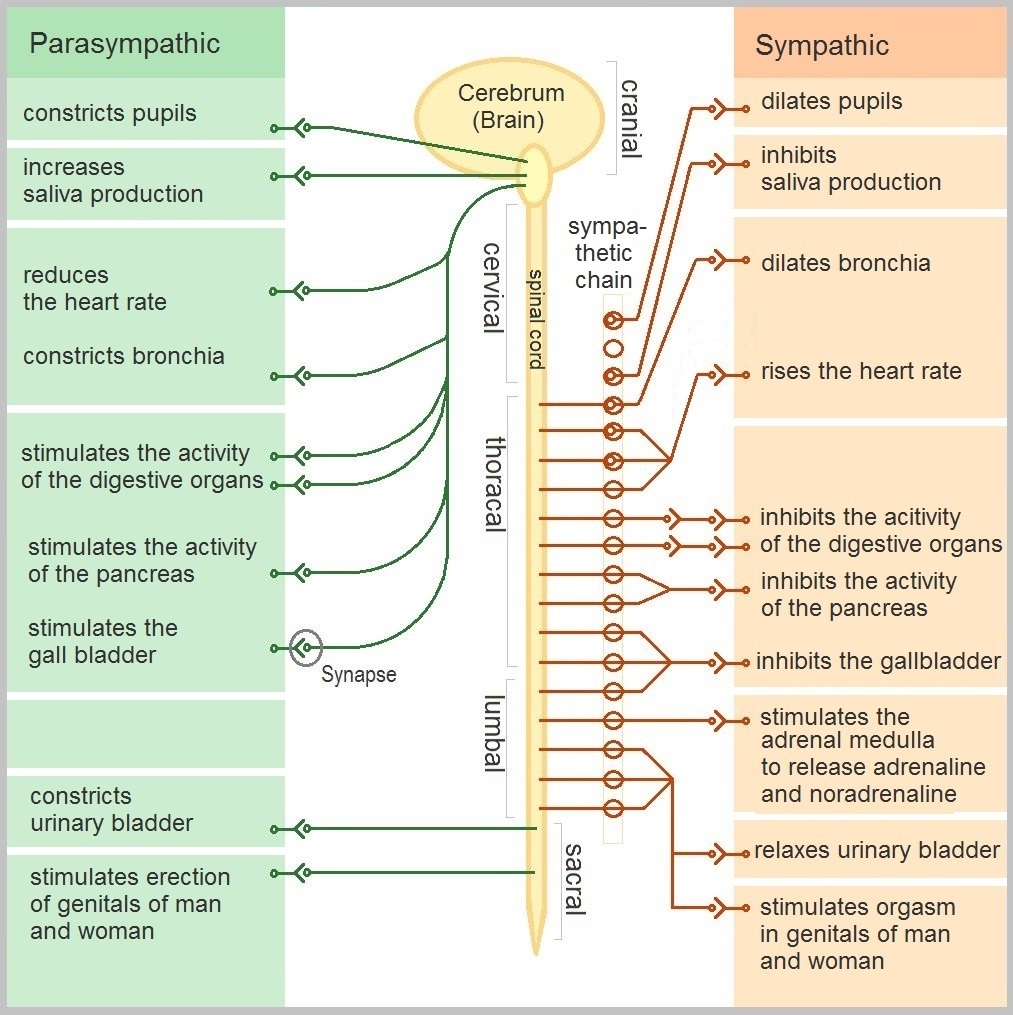11.6: Peripheral Nervous System
- Last updated
- Save as PDF
- Page ID
- 22524
One Piano, Four Hands
Did you ever see two people play the same piano? How do they coordinate all the movements of their own fingers, let alone synchronize them with those of their partner? The peripheral nervous system plays an important part in this challenge.

What Is the Peripheral Nervous System?
The peripheral nervous system (PNS) consists of all the nervous tissue that lies outside of the central nervous system (CNS). The main function of the PNS is to connect the CNS to the rest of the organism. It serves as a communication relay, going back and forth between the CNS and muscles, organs, and glands throughout the body.

Tissues of the Peripheral Nervous System
The tissues that make up the PNS are nerves and ganglia. Ganglia are nervous tissues that act as relay points for messages transmitted through nerves of the PNS. Nerves are cable-like bundles of axons that make up the majority of PNS tissues. Nerves are generally classified on the basis of the direction in which they carry nerve impulses as sensory, motor, or mixed nerves. See examples of sensory and motor never in Figure \(\PageIndex{3}\).
- Sensory nerves transmit information from sensory receptors in the body to the CNS. Sensory nerves are also called afferent nerves.
- Motor nerves transmit information from the CNS to muscles, organs, and glands. Motor nerves are also called efferent nerves.
- Mixed nerves contain both sensory and motor neurons, so they can transmit information in both directions. They have both afferent and efferent functions.

Divisions of the Peripheral Nervous System
The PNS is divided into two major systems, called the autonomic nervous system and the somatic (or sensory-somatic) nervous system. Both systems of the PNS interact with the CNS and include sensory and motor neurons, but they use different circuits of nerves and ganglia.
Somatic Nervous System
The somatic nervous system primarily senses the external environment and controls voluntary activities in which decisions and commands come from the cerebral cortex of the brain. For example, when you feel too warm, decide to turn on the air conditioner, and walk across the room to the thermostat, you are using your somatic nervous system. In general, the somatic nervous system is responsible for all of your conscious perceptions of the outside world and all of the voluntary motor activities you perform in response. Whether it’s playing piano, driving a car, or playing basketball, you can thank your somatic nervous system for making it possible.
Structurally, the somatic nervous system consists of 12 pairs of cranial nerves and 31 pairs of spinal nerves (Figure \(\PageIndex{2}\)). Cranial nerves are in the head and neck and connect directly to the brain. Sensory cranial nerves sense smells, tastes, light, sounds, and body position. Motor cranial nerves control muscles of the face, tongue, eyeballs, throat, head, and shoulders. The motor nerves also control the salivary glands and swallowing. Four of the 12 cranial nerves participate in both sensory and motor functions as mixed nerves, having both sensory and motor neurons.
Spinal nerves of the somatic nervous system emanate from the spinal column between vertebrae. All of the spinal nerves are mixed nerves, containing both sensory and motor neurons. Spinal nerves also include motor nerves that stimulate skeletal muscle contraction, allowing for voluntary body movements.
Autonomic Nervous System

The autonomic nervous system primarily senses the internal environment and controls involuntary activities. It is responsible for monitoring conditions in the internal environment and bringing about appropriate changes in them. In general, the autonomic nervous system is responsible for all the activities that go on inside your body without your conscious awareness or voluntary participation.
Structurally, the autonomic nervous system consists of sensory and motor nerves that run between the CNS (especially the hypothalamus in the brain) and internal organs (such as the heart, lungs, and digestive organs) and glands (such as the pancreas and sweat glands). Sensory neurons in the autonomic system detect internal body conditions and send messages to the brain. Motor nerves in the autonomic system function by controlling the contractions of smooth or cardiac muscle or glandular tissue. For example, when sensory nerves of the autonomic system detect a rise in body temperature, motor nerves signal smooth muscles in blood vessels near the body surface to undergo vasodilation, and the sweat glands in the skin secrete more sweat to cool the body.
The autonomic nervous system, in turn, has two subdivisions: the sympathetic division and parasympathetic division. The two subdivisions of the autonomic system are summarized in Figure \(\PageIndex{4}\). Both affect the same organs and glands, but they generally do so in opposite ways.
- The sympathetic division controls the fight-or-flight response. Changes occur in organs and glands throughout the body that prepare the body to fight or flee in response to a perceived danger. For example, the heart rate speeds up, air passages in the lungs become wider, more blood flows to the skeletal muscles, and the digestive system temporarily shuts down.
- The parasympathetic division returns the body to normal after the fight-or-flight response has occurred. For example, it slows down the heart rate, narrows air passages in the lungs, reduces blood flow to the skeletal muscles, and stimulates the digestive system to start working again. The parasympathetic division also maintains the internal homeostasis of the body at other times.
Disorders of the Peripheral Nervous System
Unlike the CNS, which is protected by bones, meninges, and cerebrospinal fluid, the PNS has no such protections. The PNS also has no blood-brain barrier to protect it from toxins and pathogens in the blood. Therefore, the PNS is more subject to injury and disease than is the CNS. Causes of nerve injury include diabetes, infectious diseases such as shingles, and poisoning by toxins such as heavy metals. Disorders of the PNS often have symptoms such as loss of feeling, tingling, burning sensations, or muscle weakness. If a traumatic injury results in a nerve being transacted (cut all the way through), it may regenerate, but this is a very slow process and may take many months.
Review
- Describe the general structure of the peripheral nervous system, and state its primary function.
- What are ganglia?
- Identify three types of nerves based on the direction in which they carry nerve impulses.
- Outline all of the divisions of the peripheral nervous system.
- Compare and contrast the somatic and autonomic nervous systems.
- When and how does the sympathetic division of the autonomic nervous system affect the body?
- What is the function of the parasympathetic division of the autonomic nervous system? What specific effects does it have on the body?
- Name and describe two disorders of the peripheral nervous system.
- Give one example of how the CNS interacts with the PNS to control a function in the body.
- For each of the following types of information, identify whether the neuron carrying it is sensory or motor and whether it is most likely in the somatic or autonomic nervous system.
- Visual information
- Blood pressure information
- Information that causes muscle contraction in digestive organs after eating
- Information that causes muscle contraction in skeletal muscles based on the person’s decision to make a movement
- The cranial nerves:
- Carry sensory information
- Carry motor information
- Are part of the somatic nervous system
- All of the above
- True or False. All of the spinal nerves carry both sensory and motor information.
- True or False. The sympathetic nervous system enhances digestion to provide more energy for the body.
Explore More
Mindfulness techniques have been shown to reduce symptoms of depression as well as those of anxiety and stress. They have also been shown to be useful for pain management and performance enhancement. Specific mindfulness programs include Mindfulness-Based Stress Reduction (MBSR) and Mindfulness Mind-Fitness Training (MMFT). You can learn more about MBSR by watching the video below.
Ever wonder why "hot" peppers are perceived as hot? Check out this link:
Attributions
- Ashton playing the piano by Dominic Smith, licensed CC BY-NC-SA 2.0 via Flickr
- The nervous system licensed CC BY-SA 4.0 via Lumen Learning
- Afferent nerve by Pearson Scott Foresman, Public domain via Wikimedia Commons
- Autonomic nervous system by Geo-Science-International, dedicated CC0 via Wikimedia Commons
- Text adapted from Human Biology by CK-12 licensed CC BY-NC 3.0


